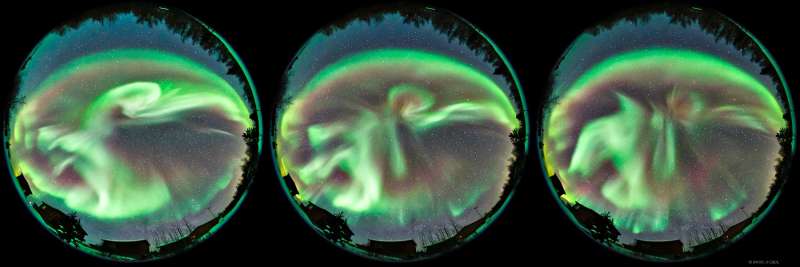Credit & Copyright: Kwon, O Chul
(TWAN)
Explanation:
Intense
auroral
activity flooded the night with
shimmering colors
on February 24, captured here from a lodge
near the city of Yellowknife in northern Canada.
The stunning sequence (left to right) of three all-sky exposures,
taken at 30 second intervals,
shows rapid changes in
dancing curtains of northern lights
against a starry background.
What makes the northern lights dance?
Measurements by NASA's fleet of
THEMIS
spacecraft indicate that these
explosions of auroral activity
are driven by sudden releases of energy in the
Earth's
magnetosphere called magnetic reconnection events.
The reconnection events release energy when
magnetic field lines snap like rubber bands,
driving charged particles
into the upper atmosphere.
Stretching
into space, these reconnection events
occur in the magnetosphere on the Earth's night side
at a distance about 1/3 of the way to the Moon.
1999 2000 2001 2002 2003 2004 2005 2006 2007 2008 2009 2010 2011 2012 2013 2014 2015 2016 2017 2018 2019 2020 2021 2022 2023 2024 2025 |
Yanvar' Fevral' Mart Aprel' Mai Iyun' Iyul' Avgust Sentyabr' Oktyabr' Noyabr' Dekabr' |
NASA Web Site Statements, Warnings, and Disclaimers
NASA Official: Jay Norris. Specific rights apply.
A service of: LHEA at NASA / GSFC
& Michigan Tech. U.
|
Publikacii s klyuchevymi slovami:
aurora - night sky - Themis - polyarnoe siyanie - severnoe siyanie - nochnoe nebo - magnitnoe pole - magnetic field
Publikacii so slovami: aurora - night sky - Themis - polyarnoe siyanie - severnoe siyanie - nochnoe nebo - magnitnoe pole - magnetic field | |
Sm. takzhe:
Vse publikacii na tu zhe temu >> | |
